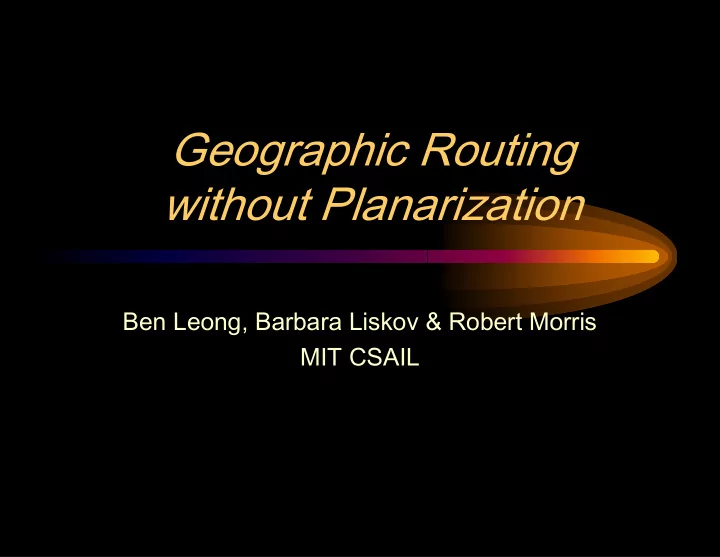

Geographic Routing without Planarization Ben Leong, Barbara Liskov & Robert Morris MIT CSAIL
Greedy Distributed Spanning Tree Routing (GDSTR) • New geographic routing algorithm – DOES NOT require planarization – uses spanning tree, not planar graph – low maintenance cost – better routing performance than existing algorithms
Overview • Background • Problem • Approach • Simulation Results • Conclusion
Geographic Routing • Wireless nodes have x-y coordinates – can use virtual coordinates (Rao et al. 2003) • Nodes know coordinates of immediate neighbors • Packet destinations specified with x-y coordinates • In general, forward packets greedily
Geographic Routing
Geographic Routing Source
Geographic Routing Destination Source
Greedy Forwarding Destination Source
Greedy Forwarding Destination Source
Greedy Forwarding Destination Source
Greedy Forwarding Destination Source
Geographic Routing: Dealing with Dead Ends Destination Source Whoops. Dead end!
Face Routing Destination Source
Face Routing Destination Source
Face Routing Destination Source
Back to Greedy Forwarding Destination Source
Back to Greedy Forwarding Destination Source
Back to Greedy Forwarding Destination Source
Planarization is Costly! • Planarization is hard for real networks – GG and RNG don ’ t work • Planarization is complicated & costly! – CLDP (Kim et al., 2005)
Greedy Distributed Spanning Tree Routing (GDSTR) • Route on a spanning tree • Use convex hulls to “ summarize ” the area covered by a subtree – convex hulls tells us what points are possibly reachable – reduces the subtree that must be traversed (smaller search problem)
Hull Tree
Hull Tree
GDSTR Example Destination Source
GDSTR Example Destination Source
GDSTR Example Destination Source
GDSTR Example Destination Source
GDSTR Example Destination Source
GDSTR Example Destination Source
GDSTR Example Destination Source
GDSTR Example Destination Source
GDSTR Example Destination Source
Revert to Greedy Forwarding Destination Source
Revert to Greedy Forwarding Destination Source
Revert to Greedy Forwarding Destination Source
Issues • Choosing forwarding direction – multiple hull trees • Undeliverable packets – conflict Hulls
Using Multiple Trees Source Destination
Using Multiple Trees Source Destination With one tree, may be forced to route in “ bad ” direction.
Using Multiple Trees Source Destination Two extremal-rooted trees are usually sufficient to “ approximate ” a void
Using Multiple Trees Source Destination Pick tree with root closest to the destination
Summary: Routing • Try greedy forwarding • Dead end: – choose tree – record start node – traverse subtree • If possible, revert to greedy forwarding • Back to start node: packet undeliverable
Theorem Given a pair of nodes s and t in connected graph G , GDSTR guarantees packet delivery from s to t .
Building Hull Trees • Convex hull info in keepalive messages • Choose roots: – minimal and maximal x-coordinates • Want compact trees – minimal hop count from root • Aggregate convex hulls from leaves to root • Conflict hull info percolates from root to leaves
Simulation Results • Measured 2 routing metrics: – Path Stretch – Hop Stretch • Topologies – range of network densities (average node degree) – larger networks up to 5,000 nodes • low/high density • low/high obstacle density
Simulation Results • Compare with – GPSR (Karp, 2001), – GOAFR+ (Kuhn, 2003) and – GPVFR (Leong et al., 2005) under CLDP planarization (Kim et al., 2005) • Measured costs and compared with CLDP: – storage – bandwidth
Hop Stretch
Hop Stretch
Costs • Computation: – convex hull computation: O(log n) operations [Graham ’ s scan] • Storage: < 1 kb • Bandwidth
Message Sizes
Messages for Startup
Messages for Stabilization
Summary • Maintenance cost one order of magnitude less than CLDP (face routing) • Better routing performance (stretch) – up to 20% better
Large Voids
Small Voids
Explaining Performance Source Destination
Explaining Performance Source Destination
Explaining Performance Source Destination
Explaining Performance Source Destination
Explaining Performance Source Destination
Explaining Performance Source Destination
Explaining Performance Source Destination Extra overhead
Summary • Sparse networks – GDSTR chooses correct forwarding direction more often than face routing • Moderately dense networks – Faces are small, forwarding direction is inconsequential – Trees do not “ approximate ” small voids well • Ultra-dense networks – Greedy forwarding works all the time!
Conclusion Cheaper to maintain two hull trees • than a planar graph “ Global ” information allows GDSTR • to choose good forwarding direction more often GDSTR achieves improved routing • stretch at lower maintenance cost than CLDP
Future Work • Evaluate GDSTR in a practical and mobile setting • Geographic routing in higher dimensions – convex hulls generalizable to higher dimensions
Geographic Routing without Planarization Ben Leong, Barbara Liskov & Robert Morris MIT CSAIL
Reducing Convex Hulls
Reducing Convex Hulls
Reducing Convex Hulls
Conflict Hulls • Undeliverable packets will be forwarded to the root. • Conflict hulls allow us to avoid forwarding to the root • Key idea : parent nodes tell child nodes about other nodes with intersecting hulls
Example: Conflict Hull
Example: Conflict Hull
Example: Conflict Hull
Example: Conflict Hull
Example: Conflict Hull
Example: Conflict Hull Forward to parent …
Example: Conflict Hull Packet undeliverable!
Example GDSTR Hull Trees Minimal-x Tree Maximal-x Tree
Comparing Routing Topologies Planar Graph Two Trees (CLDP)
Recommend
More recommend